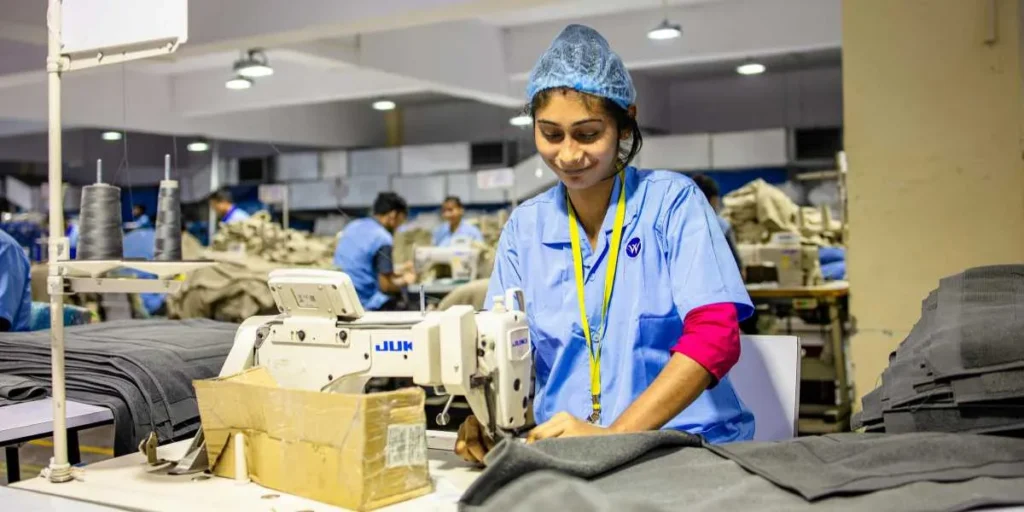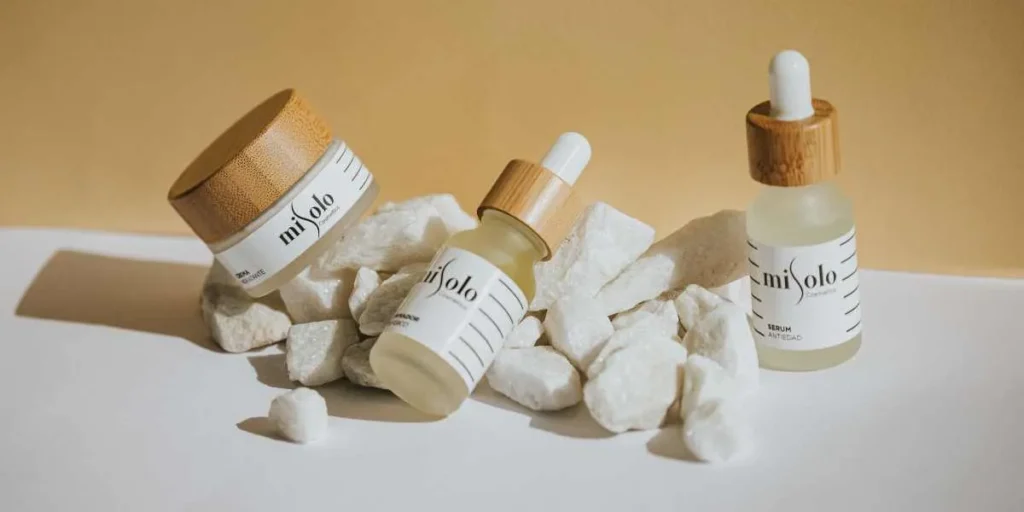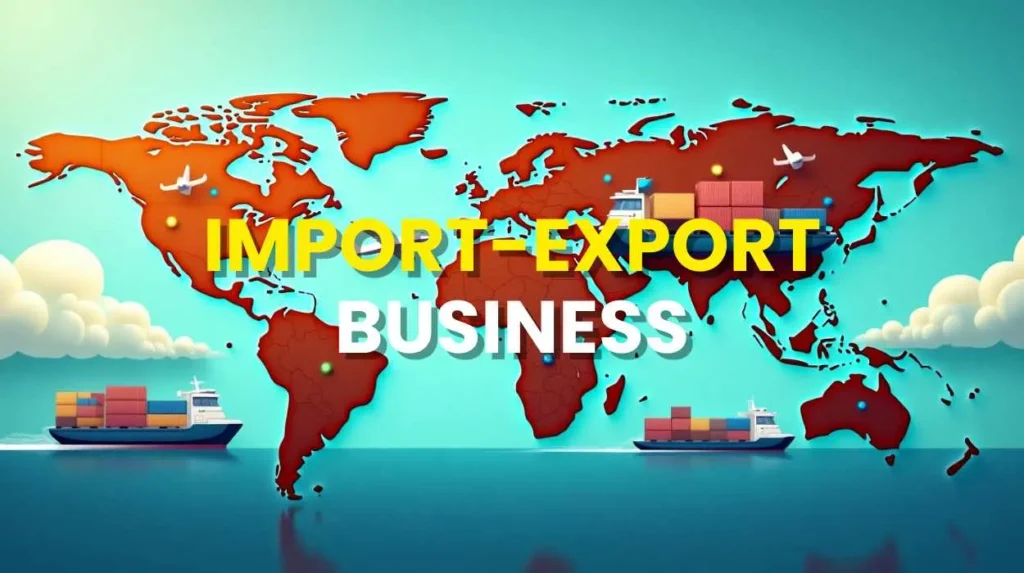Have you ever wondered how that tasty Indian spice gets to a kitchen in Europe or how the phone in your pocket that was designed in California and manufactured in China gets to your neighborhood shop? The solution is the import-export business- a lively and frequently profitable industry that connects the world with commerce. This region provides new business people with an opportunity to expand internationally and huge growth potentials.
Trade in the world is larger than ever:
- The world trade organization (WTO) estimates that the volume of global merchandise trade will grow by 2.6 percent in 2024 and 3.3 percent in 2025, recovering robustly and demonstrating stable demand.
- India is a major global supplier with its merchandise exports reaching a record figure of $437.06 billion in the fiscal year 2023-24.
- The global cross-border B2B e-commerce market is growing at a rapid pace and is projected to hit close to 4.95 trillion dollars by 2028, which provides digital opportunities to traders that never existed before.
- Most importantly, the growth is carried by the Micro, Small, and Medium Enterprises (MSMEs) which account for nearly 45 percent of the total exports in India. This shows that you do not need to be a large corporation to make it.
And, in case you have a dream of starting an import export business that is transnational, begin here. This guide simplifies all you need to know, including the fundamentals, tangible business concepts and a step-by-step launch plan, in simple, everyday language.
What Is An Import-Export Business?
Import-export business is simple in a nutshell. It is importing goods to your country followed by exporting them to another. Imagine yourself as an intermediary between the suppliers and buyers. Find something that people desire in your country, but cheaper or higher quality in another country.
- Importing: Source and buy goods in another country and sell them at home. An example is an Indian business person who may import high-tech electronics in South Korea or gourmet cheese in France to the Indian market.
- Exporting: Locate buyers abroad who will take the products produced or imported at home. The same entrepreneur may export Indian spices, textiles or handicrafts to the USA or Middle Eastern markets.
You may be a direct exporter/importer and do everything yourself, or you may be an agent that connects local sellers with foreign buyers and receive a commission. In any case, you are contributing to the movement of goods and services in the world.
Key Requirements To Start An Import Export Business
Before you can trade, you must establish a good legal and financial foundation. The following are the key requirements in India:
- Business Registration: Select a legal structure-Sole Proprietorship, Partnership Firm, Limited Liability Partnership or Private Limited Company. International trade is usually conducted using a company structure since it creates greater credibility.
- PAN Card: All financial transactions require you to have a Permanent Account Number (PAN) card of your business entity.
- Present Bank Account: Open a current account in the name of your business to make all trade related transactions.
- Import Export Code (IEC): This is the most important license. The IEC is a ten-digit number given by the Directorate General of Foreign Trade (DGFT) and it is compulsory to any individual who would want to import or export to or out of India.
- GST Registration: The claim of tax benefits and adherence to the national tax laws requires registration of Goods and Services Tax (GST).
- Registration Cum Membership Certificate (RCMC): Although not required in all cases, an RCMC issued by the appropriate Export Promotion Council (e.g. APEDA in case of agricultural products, AEPC in case of apparel) can enable you to access a number of export incentives.
- AD Code: The Authorised Dealer (AD) Code is a 14 digit code given by the bank in which you have your current account. It should be registered at the customs in all the ports you intend to clear shipments.
Best Import Export Business Ideas For 2025
The most difficult part is to select the right product. The following are 20 new import export business ideas: 10 to sell overseas and 10 to import overseas that may become big sellers by 2025 and beyond.
A. Export Business Ideas (from India)
1. Sustainable Textiles and Apparel

The fashion industry in the world is becoming sustainable. Europeans and North Americans desire clothes made of organic cotton, linen, hemp and recycled materials. They are willing to spend more on environmentally friendly and ethically produced clothes. India is in a good position to address this need because it is a textile giant with high natural fabrics and craftsmen. It is the best import export business. Organic cotton t-shirts, yoga wear, hand-block printed linen dresses and other recycled fabrics products are planned to be exported to the increasingly conscious consumer market.
- Why it is profitable: Western markets are interested, high prices on green products, and powerful Indian production.
- Investment Required: 2 Lakh-15 Lakh (average) (will depend on whether you are a manufacturer or a sourcer)
- Profit Potential: 30 to 70 % margins.
- How to start: Find GOTS (Global Organic Textile Standard) certified manufacturers, develop a powerful brand narrative about sustainability and sell on social media and environmentally-friendly marketplaces such as Etsy.
2. Spices and Spice Blends
India is the so-called Spice Bowl of the World. Everywhere people desire authentic, exotic flavours. It is not enough to sell plain old turmeric or black pepper. The larger opportunity is to produce special, value added products. Consider making blended spices that are specific to a dish (“Butter Chicken Masala,” by way of example), single-origin, organic spices, or gift sets that are pretty to look at. This is appealing to home cooks, food enthusiasts, and high-end shops beyond India since they do not get the same convenience or authenticity in their domestic supermarkets.
- Why it is profitable: India is the largest producer of spices, it is cheap, the demand is high and the addition of value provides high margins.
- Investment Required: Approximately 1 Lakh – 5 Lakh.
- Profit Potential: 40% – 60% profit margin
- How to start: Purchase spices of high quality at the farms; obtain a food license issued by the FSSAI; invest in good packaging; and seek customers in B2B portals and international food fairs.
3. Ayurvedic and Herbal Wellness Products
The world wellness industry is expanding rapidly and the ancient Indian medicine system, Ayurveda, is enjoying massive respect and fame. Consumers all over the world are seeking natural, whole-body options over conventional health products. Herbal supplements (Ashwagandha, Tulsi), Ayurvedic skin care (face oils, ubtans), herbal teas and essential oils are some of the products that this business exports. It is the best import export business. To capture foreign consumers, concentrate on quality, authenticity and appropriate certifications (such as AYUSH certification). Trust is the most important thing, and global shoppers, who are becoming more health conscious and seek natural solutions, will pay attention.
- Why it is profitable: Increasing worldwide demand in natural and holistic wellness, high perceived value, and the knowledge base that is unique to India.
- Investment Required: 3 lakh to 10 lakh (this price is inclusive of R&D and certifications).
- Profit potential: 50 %-150 %.
- How to start: Cooperate with certified Ayurvedic manufacturers, invest in clinical testing and packaging of the highest level, and use content marketing to educate your target audience.
4. Handicrafts and Artisan Home Decor

The era of mass production is in favour of things that cannot be easily replicated. Home decor is in demand with Indian handicrafts, bright colors, elaborate designs, and rich stories. These are no mere trifles. Large-scale products like hand-knotted rugs, blue pottery, wooden furniture with brass inlay, marble tabletops and macrame wall hangings are now being exported by people. These products appeal to interior designers, boutique home-decor shops, and people who want to give their homes a touch of trendy bohemian or ethnic chic, but they are durable as well as one-of-a-kind.
- Why it is profitable: These products are not directly competitive, they carry a high-value image, support local artisans and there is a powerful demand in the home-decor market.
- Investment Required: 2 Lakh – 8 Lakh.
- Profit potential: 60 – 200%.
- How to start: Go to work with artisan groups directly to guarantee fair trade, create a catalogue with professional photos, and sell via such sites as Etsy, Chairish, or even to overseas stores directly.
5. Processed and Packaged Foods
There are Indian people in numerous countries and they are homesick. Meanwhile, all over the world, individuals are more ready to experiment with food. This provides an opportunity to export processed and ready to eat (RTE) Indian foods. Do not just stick to snacks. The market is open to quality mango pulp, dehydrated vegetable products, retort packed curries and biryanis, frozen parathas, gourmet pickles and chutneys. It is the best import export business. The products are convenient and provide genuine taste to millions of people, including busy professionals in the UK and students in Canada, which makes it an ever-increasing export category.
- Why it is profitable: There is a huge demand by both the Indian diaspora and international foodies, long shelf life lowers the risk and value addition results in good margins.
- Investment Required: 5 Lakh- 20 Lakh (needs food processing and packaging units).
- Profit Potential: 30 – 60 percent.
- How to start: Get FSSAI and FDA licenses, establish a hygienic processing facility, concentrate on new and appealing packaging and market to ethnic food distributors in other countries.
6. Auto Components and Engineering Goods
India is becoming an international hub of production of engineering goods particularly in automobiles. This is B2B business: India exports precision auto parts such as gears, pistons, engine parts and rubber fittings to automakers and aftermarket dealers in Africa, Latin America and Eastern Europe. The quality and competitiveness of the Indian engineering products have been increased through the Make in India program. It is a volume-based business, requires technical expertise, and has stable long-term contracts and good growth prospects since global supply chains are no longer using single countries as a source of supply.
- Why it is profitable: low cost of manufacturing in India, increasing demand for reliable auto parts across the globe, and the potential of large and recurring orders.
- Investment Required: 10-50 lakh (will have to be sourced out of ISO/TS certified manufacturers).
- Potential profit: 20-40%.
- How to start: Select a niche, find ISO/TS certified manufacturers, visit international auto shows and trade fairs, and establish contacts with foreign distributors.
7. Leather and Non-Leather Goods

India produces quality leather products-handbags, wallets, belts and shoes. However, the increased veganism has created a new niche of selling products that do not contain any leather at all. Some of the materials used to make these products are polyurethane (PU), cork, or even pineapple leaf fiber (Piatex). Firms now export these accessories to the fashion conscious consumers. You will be able to cover a broad market, including luxury shoppers and environmentally conscious millennials by offering both conventional leather products and vegan ones.
- Why it is profitable: India possesses artisanship, its brands will potentially have a high value, and the company will be able to cater to luxury and ethical consumers.
- Investment Required: The investment may be between 5 Lakh and 25 Lakh.
- Potential profit: The profit may be 40 to 100%.
- How to start: Partner with well-established manufacturing units in the areas such as Kanpur, Agra or Chennai. Make your own designs and brand and promote it via online lookbooks and fashion trade shows.
8. Gems and Jewellery
India is a world leader in diamond cutting and polishing and a large centre of gold and silver jewellery. It is a high trust, high value business. The potential is not only in the exportation of traditional heavy wedding jewellery but also in the minimalist, modern jewellery with the use of semi precious stones, which attract a younger, international market. It is the best import export business. Another profitable option is exporting certified loose diamonds and gemstones to jewellery makers in such destinations as Antwerp, Hong Kong, and New York. The industry is capital intensive and needs expertise in the field but with one of the best returns in the export business.
- Why it is profitable: The product is high value, there is already Indian expertise, and the market demand both in the traditional and modern designs is always there across the globe.
- Investment Required: 25 Lakh. Maximum Investment: 2 Crore+.
- Profit Potential: 25-60 percent.
- How to Start: Become a member of the Gem & Jewellery Export Promotion Council (GJEPC), create a base of suppliers and buyers to trust, employ safe logistics, and have adequate insurance.
9. Pet Supplies

The pet-care market is expanding rapidly around the world as people have started to regard their pets as family members. This anthropomorphism of pets has led to high demand for high-quality supplies. India is a manufacturing powerhouse and it can export a variety of products in this niche. Consider pet toys that last, trendy leashes and collars, comfortable pet bedding, organic pet grooming products (shampoos, conditioners) and even healthy, natural pet treats. It is an entertaining, emotionally appealing industry in which a brand and quality can create a highly loyal global consumer base.
- Why it is profitable: Fast expanding international market. Pet owners spend a lot of money on emotions. Capacity to develop a well established brand
- Investment Required: 3 Lakh to 12 Lakh.
- Profit Potential: 40 – 80 percent.
- How to Start: Research in pet trends in the countries of interest (e.g. USA, Germany). Offer safety and quality of products. Develop eye grabbing branding. Sell in international pet-oriented online stores.
10. IT and Software Services
Exporting does not refer to physical goods only. India is a super power in information technology all over the world. Services exporting has the potential of being a very lucrative and scalable business model with little logistical headaches. You engage in such things as custom software development, mobile app development, web design, digital marketing (SEO, SMM) and remote tech support of clients across North America, Europe and Australia. The 24-hour work can even become an advantage due to the time-zone difference. This company takes advantage of the high number of skilled English-speaking tech talent in India to provide high quality services at a competitive rate.
- Why it is profitable: does not require any physical inventory, shipping costs, high-profit margins, the business model is scalable, and has access to a huge global pool of clients.
- Investment Required: 50,000 – 5 Lakh (mainly a good site, marketing and a small team).
- Profit potential: 60 – 200+ %
- How to Start: Create a professional portfolio, create an account on freelance websites like Upwork and Toptal, use digital marketing to find foreign clients, and focus on good communication.
B. Import Business Ideas (to India)
1. Advanced Electronics and Gadgets

India has one of the biggest and fastest growing consumer markets in the world. It desires new technology in a hurry. India has become a hub of assembling many electronics but still has to import the high-end parts and finished products that are not locally produced. It is the best import export business. These are manufacturer-specific parts (such as high-end semiconductors), high-end consumer devices (drones, smart home devices, high-fidelity audio equipment), and refurbished electronics by countries, including the USA and UAE. This company is addressing the Indian appetite on the latest technology and worldwide brands.
- How it is profitable: Massive and expanding domestic demand, the high perceived value of foreign brands and high margins on high-end products.
- Investment Required: 10 Lakh – 50 Lakh.
- Profit potential: 15 – 40%.
- How to Start: Find a niche gadget type, get distributorship of foreign brands, learn about import duties and certifications (such as BIS) and establish a good online and offline distribution channel.
2. Gourmet and Specialty Foods
The consumer market in India is very large and rapidly expanding. Here, people desire the most up-to-date technology and they will gladly purchase it. India now produces some of its electronic devices but local factories continue to import high-end components and products. These imports are highly sophisticated semiconductors to manufacturers, high-end consumer devices like drones, smart home devices and high fidelity audio equipment, and refurbished goods such as in the USA and the UAE. The company is successful due to the fact that Indian customers appreciate foreign brands, want to have up-to-date products and are ready to pay more money on them.
- How it is profitable: Demand within the industry is high. The value of foreign brands is perceived to be high. High profitability on high end products
- Investment Required: 10 Lakh to 50 Lakh
- Potential profit: 15-40%
- How to start: Select a niche type of gadget. Obtain a distributorship of an overseas brand. Be aware of the import duties and certification requirements, e.g. BIS certification. Establish an effective online and offline distribution channel.
3. Industrial and Heavy Machinery
The Make in India program is designed to increase the local production. In order to achieve this, most Indian firms have to import superior industrial machines and equipment that India has not yet developed. They require precision machines of CNC made in Germany or Japan, special construction equipment, sophisticated packaging equipment and textile working machines. It is a B2B venture in which you sell the tools that drive the industrial growth of India. It requires technical expertise and large capital but provides stable and high value deals with industries all over the country.
- Why it is profitable: High ticket value per transaction, necessity of such equipment in the growth of industries and long-term service and maintenance contracts are potential.
- Investment Required: 50 Lakh – 5 Crore+.
- Profit Potential 20% -50%.
- How to Start: Specialize in machinery in a particular industry (e.g. food processing, automotive), with major international manufacturers, offer installation and after sales service and network at industry trade shows.
4. Korean Cosmetics and Skincare

The K-beauty trend has swept the global beauty industry and also the Indian one. Korean skincare is desired by many Indians inspired by social media and K-dramas. The products contain special ingredients (such as snail mucin and cica) in clever formulas, and they have fun packaging. It is the best import export business. The company is straightforward: import trendy Korean beauty brands-sheet masks, serums, cleansers, and sunscreens, and sell them in India. The demand is so high that most of the items already have a cult following prior to their launching in the country.
- Why it is profitable: Viral trend with huge demand, high-profit margins and loyal consumers.
- Investment Required: 5 Lakh – 25 Lakh.
- Potential profit: 50-150%.
- How to Start: Obtain a license to import cosmetics issued by the CDSCO, become a certified distributor of popular Korean brands, make influencer marketing work, and sell through online stores such as Nykaa and your web store.
5. Scrap Metal
The scrap metal importing is a highly lucrative and significant occupation. The factories and infrastructure of India require copious quantities of steel, aluminium and copper. Recycling of scrap metal is often less expensive and less energy-intensive than mining raw ore. This is done by purchasing processed scrap in developed countries such as the United States of America, the United Kingdom, and the United Arab Emirates which are then sold to foundries and steel mills in India. It is a business that is based on trading large quantities and thus requires an understanding of the various grades of scrap and the way the international shipping systems work.
- Why it is profitable: The industries in India continue to consume scrap metal that is one of the important raw materials and the trade can be enormous.
- Investment Required: 20 lakh to 1 crore+ (depending on the size of each shipment).
- Profit potential: 10 – 25%.
- How to start: Obtain the appropriate environmental and pollution control permits, establish contacts with scrap yards overseas and recycling facilities in India and understand the process of container shipping.
6. Toys and Baby Products
The safety of toys and baby paraphernalia, its quality, and learning value are a major concern of Indian parents nowadays. Due to this fact, a lot of consumers seek trustworthy products that have been manufactured overseas with high safety regulations. These are products which can be the certified baby cars seats, strollers, educational toys of European brands, and creative play items which are imported in large quantities. Doubling on safety and educational advantages will help the companies gain the trust of parents, which is a significant advantage in the current market, where competition is high.
- Why it is profitable: Parents tend to pay more on products that they perceive as safe and educational and this is fuelled by increased awareness of the developmental needs and emotional attachment to their children.
- Investment Required: The amount you will require to invest is 8 Lakh to 30 Lakh.
- Profit potential: It is between 30 and 70%.
- How to start: Ensure all products are BIS toy safety-certified, become a distributor of established international brands and build a community of parents with workshops and online content.
7. Furniture (Flat-Pack and Modular)

India is rapidly developing and a large number of individuals reside in small apartments nowadays. Due to this, there is an increasing demand of smart and space saving furniture. Flat-pack (ready-to-assemble) and modular furniture has proved to be very successful with brands like IKEA. This company imports trendy and practical furniture manufactured in such centers as China, Vietnam, or Malaysia. It is more concentrated on contemporary design, low prices, and comfort. The model is very scalable and it caters to the demands of young professionals, renters and first time homeowners in urban India.
- Why it is profitable: It is in great demand in cities, shipping of flat-pack products is cheaper, and the furniture fits the contemporary style.
- Investment Required: 15 Lakh – 70 Lakh.
- Potential profit: 30-60%.
- How to Start: Collaborate with mass furniture production in Southeast Asia, create an online catalogue and experience store and provide assembly services to improve the customer experience.
8. Sports and Fitness Equipment
Health awareness hit rates are at an all-time high in India and that is driving the increase in demand of the highest quality sports and fitness equipment. Although simple equipment can be produced domestically, there is a large demand to purchase specialized gym machines, high-performance athletic equipment, high-quality yoga mats, and advanced fitness trackers. It is the best import export business. You may go to commercial gyms, housing society clubhouses or sell to home-gym enthusiasts. This enterprise is aligned with the wellness lifestyle trend that is taking over urban India.
- Why it is profitable: Health and wellness trends are growing, commercial gyms and individuals have strong demand, and specialized equipment has good margins.
- Investment Required: 10 lakh- 40 lakh.
- Profit Potential: 25 – 50%.
- How to Start: Become a distributor of famous international fitness brands, provide installation and maintenance, create a community with fitness events and collaborations with trainers.
9. Medical and Diagnostic Equipment

The healthcare industry in India is expanding rapidly. New hospitals and clinics are being established all over the place and they require sophisticated medical and diagnostic equipment. It is high-tech equipment: MRI machines, digital X-ray systems, advanced surgical equipment, and sophisticated laboratory equipment that India is not yet producing. The business of importing such goods is high value and high risk. It requires great expertise in the healthcare sector and regulatory clearances, including the CDSCO, yet it also assists in enhancing healthcare outcomes nationwide.
- Why it is profitable: The healthcare industry is one of the most essential industries; it has a very high ticket value, and it provides recurring revenue through consumables and service contracts.
- Investment Required: 1 Crore- 10 Crore+.
- Profit Potential: 30 – 60 %.
- How to start: Become an expert in a certain medical specialty, obtain all the regulatory approvals, develop a good relationship with the hospitals and physicians, and offer good after sales service and training.
10. Renewable Energy Components
India is keen on achieving large output in renewable energy, particularly in solar energy. India is currently the largest manufacturer of most solar panels. Nevertheless, there is increasing demand of imported parts which are more efficient and quicker. These components consist of sophisticated solar inverters, high-powered lithium-ion batteries to store energy and specialized manufacturing machines to produce solar panels. It is the best import export business. With such high-quality components, you will advance the green energy transition in India and allow your business to be at the forefront of a green future.
- Why it is profitable: The government is insisting on renewable energy. No large-scale manufacture of these parts is yet available in India. The green technology B2B market is expanding rapidly.
- Investment required: approximately 50 lakh to 2 crore.
- Profit potential: 20-40 %
- How to Start: Find partners that provide these parts in such countries as Germany or China. Find out their technical specifications and certificates they are required to have. Discuss with the developers of the large-scale solar projects in order to get additional business.
Profitable Niches In The Import Export Space
Big ideas are good, but it is sometimes the wisest thing to do to niche down. This implies selecting a specific product and targeting it at a very narrow audience. This will reduce competition and make you a leader in the field.
These are some of the money-making niches to consider:
- Sustainable and Vegan Goods: An example is that you may export vegan leather shoes or import plant-based meat alternatives.
- Ethnic Foods to Diaspora: You may sell certain local Indian snacks (such as Gujarati Farsan) to regions with a large number of Gujarati in the United States.
- Pet Tech: Import smart pet feeders, pet cameras and GPS collars.
- Dropshipping Niche Products: You can open an online store in a different country and have the products shipped to the customer by the manufacturer (say in China).
- Fair-Trade Products: Concentrate on products that are purchased in a moral manner and are remunerated well to the artisan or farmer.
Conclusion
Import export business is not merely a means of getting money. It is a bridge which connects cultures, economies and people. It is capable of providing large opportunities to any individual who is industrious, inquisitive and resilient. All it takes is to locate a good product, locate a market that desires it and establish a consistent process to get the product moving.
The world is closer than ever before and technology is easing every step. There is no better time to begin. Start small, continue to learn, and establish good relationships. The idea of having a global business is not an unattainable dream, but a realizable objective that can be achieved, shipment by shipment.
FAQs
How much money do I require to set up an import-export business?
No, you do not. It may be small to start by purchasing in local markets or you can start as a trade agent/consultant with little investment and earn a commission by linking buyers and sellers.
What is an IEC Code and is it obligatory?
Import Export Code (IEC) is a 10 digit unique code issued by the DGFT, Government of India. Importing or exporting goods or services is an obligation of any individual or company.
Where do I get customers for my export products?
Identification of buyers can be done online via B2B portals (such as Alibaba, Global Sources), by attending international trade fairs, by registering with Export Promotion Councils, and through professional networks, such as LinkedIn.
Is the business of import and export very risky?
Yes, this kind of business is not without risks, including default payment and shipping damages. The risks can be well controlled through secure payment opportunities such as a Letter of Credit and ensuring that you insure your cargo at all times.

